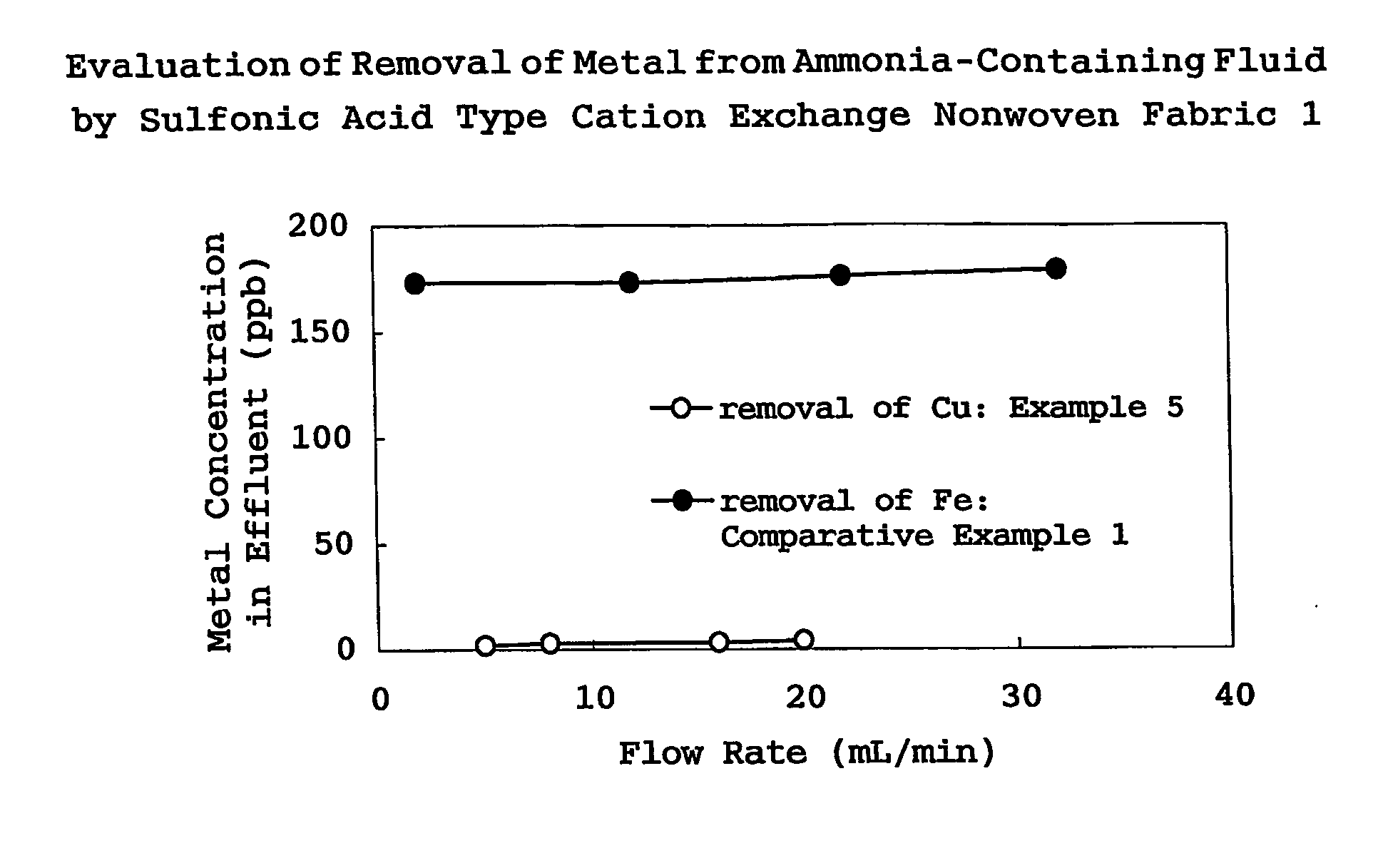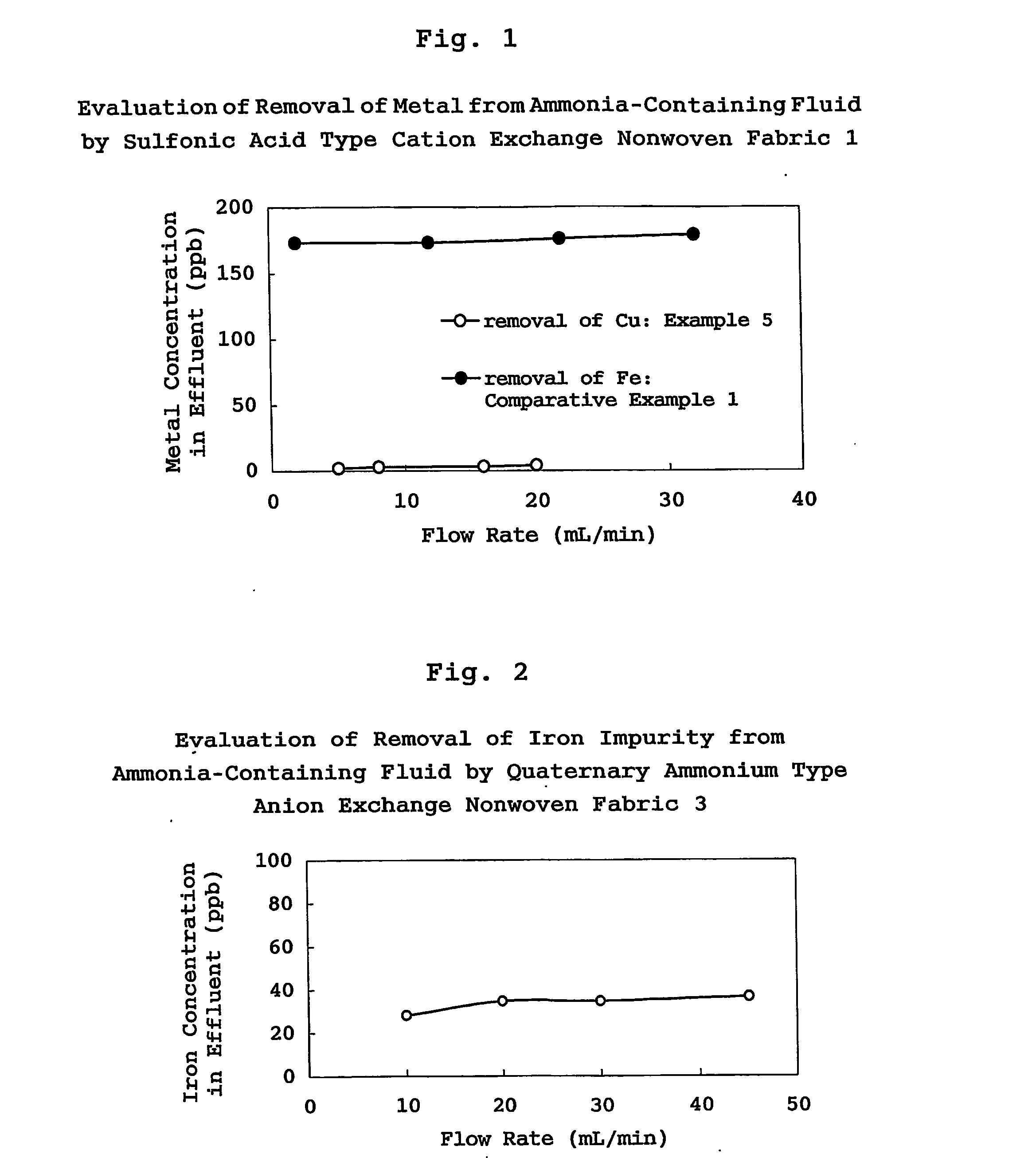Filter cartridge for fluid for treating surface of electronic device substrate
a technology of filter cartridges and electronic devices, applied in the field of filter cartridges, can solve the problems of increasing the requirement for the cleanliness of chemical fluids to be used, and affecting the production yield of semiconductor devices
- Summary
- Abstract
- Description
- Claims
- Application Information
AI Technical Summary
Benefits of technology
Problems solved by technology
Method used
Image
Examples
example 1
Preparation of Sulfonic Acid Type Cation Exchange Nonwoven Fabric
[0041] Eighty-three grams of a nonwoven fabric made of polyethylene fibers (a product of Du Pont, trade name “Tyvek”, average fiber diameter: 0.5 to 10 μm, average pore diameter: 5 μm (measured by the bubble-point method), a real density: 65 g / m2, thickness: 0.17 mm) was irradiated with electron beams at 150 kGy in a nitrogen atmosphere. This irradiated nonwoven fabric was impregnated with styrene and placed in a glass vessel. Pressure in the vessel was reduced using a vacuum pump, and graft polymerization reaction was conducted at 50° C. for three hours. The grafted nonwoven fabric was taken out and treated in toluene at 60° C. for three hours to remove homopolymers. The obtained nonwoven fabric was further washed with acetone and then dried at 50° C. for 12 hours to obtain 136 g of a styrene-grafted nonwoven fabric. The grafting ratio was 64%.
[0042] The obtained styrene-grafted nonwoven fabric was dipped in a chlo...
example 2
Preparation of Quaternary Ammonium Type Anion Exchange Nonwoven Fabric
[0043] Two hundred and thirteen grams of the nonwoven fabric as in Example 1 was irradiated with electron beams under the same conditions as in Example 1, and then dipped in chloromethylstyrene (450 g, a product of Seimi Chemical, trade name “CMS-AM”) in a glass vessel. After reducing the pressure in the vessel by a vacuum pump, graft polymerization reaction was conducted at 50° C. for three hours. The resulting nonwoven fabric was taken out and washed three times with acetone (3 L) and dried at 50° C. for 12 hours to obtain 430 g of a chloromethylstyrene-grafted nonwoven fabric. The grafting ratio was 102%. The obtained grafted nonwoven fabric was dipped in a mixed solution of a 30% trimethylamine aqueous solution (600 mL), ethanol (1 L) and pure water (2.8 L). The reaction was conducted at 50° C. for 24 hours to form quaternary ammonium groups. The resulting nonwoven fabric was taken out and washed with pure w...
example 3
Preparation of Iminodiethanol Type Chelating Nonwoven Fabric
[0044] Eighty-three grams of a nonwoven fabric irradiated with electron beams under the same conditions as in Example 1 was impregnated with chloromethylstyrene (a product of Seimi Chemical, trade name “CMS-14”) and placed in a glass vessel. After reducing pressure by a vacuum pump, graft polymerization reaction was conducted at 50° C. for three hours. The resulting nonwoven fabric was taken out and treated in toluene at 60° C. for three hours to remove homopolymers. The resulting nonwoven fabric was further washed with acetone, and then dried under reduced pressure at 50° C. for 12 hours to obtain 154 g of a chloromethylstyrene-grafted nonwoven fabric. The grafting ratio was 85%. This nonwoven fabric was dipped in an iminodiethanol / isopropyl alcohol mixed solution (4:6 by weight ratio), and the reaction was conducted at 70° C. for 12 hours. The resulting nonwoven fabric was taken out and washed with methanol and then pur...
PUM
| Property | Measurement | Unit |
|---|---|---|
| pore diameter | aaaaa | aaaaa |
| diameter | aaaaa | aaaaa |
| pore diameter | aaaaa | aaaaa |
Abstract
Description
Claims
Application Information
 Login to View More
Login to View More - R&D
- Intellectual Property
- Life Sciences
- Materials
- Tech Scout
- Unparalleled Data Quality
- Higher Quality Content
- 60% Fewer Hallucinations
Browse by: Latest US Patents, China's latest patents, Technical Efficacy Thesaurus, Application Domain, Technology Topic, Popular Technical Reports.
© 2025 PatSnap. All rights reserved.Legal|Privacy policy|Modern Slavery Act Transparency Statement|Sitemap|About US| Contact US: help@patsnap.com



